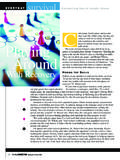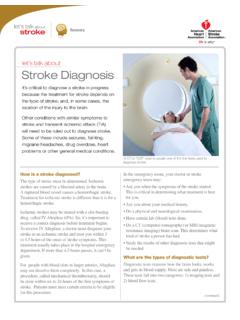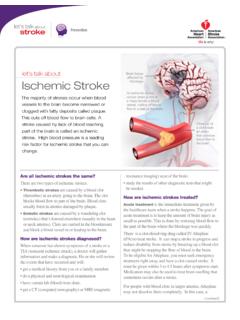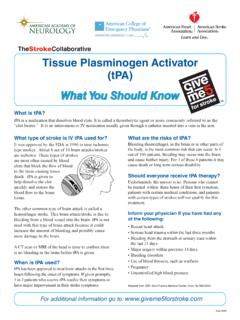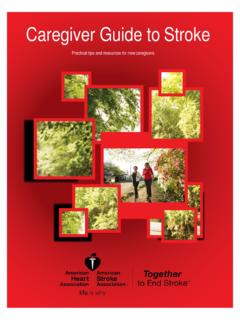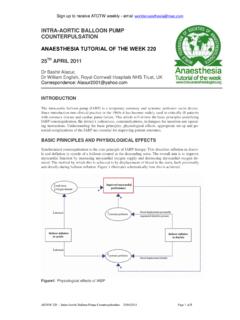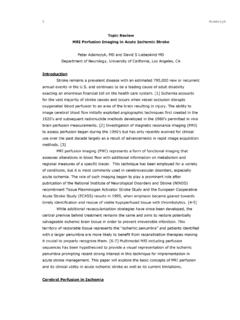Transcription of AHA/ASA Guideline 2015 AHA/ASA ... - Stroke Association
1 AHA/ASA Guideline 2015 AHA/ASA Focused Update of the 2013 guidelines for the Early Management of Patients With Acute Ischemic Stroke Regarding Endovascular Treatment A Guideline for Healthcare Professionals From the American Heart Association /American Stroke Association The American Academy of Neurology affirms the value of this Guideline as an educational tool for neurologists. Endorsed by the American Association of Neurological Surgeons (AANS); Congress of Neurological Surgeons (CNS); AANS/CNS Cerebrovascular Section; American Society of Neuroradiology; and Society of Vascular and Interventional Neurology William J. Powers, MD, FAHA, Chair; Colin P. Derdeyn, MD, FAHA, Vice Chair; Jos Biller, MD, FAHA; Christopher S. Coffey, PhD; Brian L. Hoh, MD, FAHA; Edward C. Jauch, MD, MS, FAHA; Karen C. Johnston, MD, MSc; S. Claiborne Johnston, MD, PhD, FAHA; Alexander A. Khalessi, MD, MS, FAHA; Chelsea S. Kidwell, MD, FAHA; James F. Meschia, MD, FAHA; Bruce Ovbiagele, MD, MSc, MAS, FAHA; Dileep R.
2 Yavagal, MD, MBBS; on behalf of the American Heart Association Stroke Council Powers et al 1 DOI: by guest on March 16, 2016 from The American Heart Association makes every effort to avoid any actual or potential conflicts of interest that may arise as a result of an outside relationship or a personal, professional, or business interest of a member of the writing panel. Specifically, all members of the writing group are required to complete and submit a Disclosure Questionnaire showing all such relationships that might be perceived as real or potential conflicts of interest. This statement was approved by the American Heart Association Science Advisory and Coordinating Committee on June 5, 2015 , and the American Heart Association Executive Committee on June 12, 2015 . A copy of the document is available at by selecting either the By Topic link or the By Publication Date link. To purchase additional reprints, call 843-216-2533 or e-mail The American Heart Association requests that this document be cited as follows: Powers WJ, Derdeyn CP, Biller J, Coffey CS, Hoh BL, Jauch EC, Johnston KC, Johnston SC, Khalessi AA, Kidwell CS, Meschia JF, Ovbiagele B; Yavagal DR; on behalf of the American Heart Association Stroke Council.
3 2015 AHA/ASA focused update of the 2013 guidelines for the early management of patients with acute ischemic Stroke regarding endovascular treatment: a Guideline for healthcare professionals from the American Heart Association /American Stroke Association . Stroke . 2015 ;46: . Expert peer review of AHA Scientific Statements is conducted by the AHA Office of Science Operations. For more on AHA statements and guidelines development, visit and select the Policies and Development link. Permissions: Multiple copies, modification, alteration, enhancement, and/or distribution of this document are not permitted without the express permission of the American Heart Association . Instructions for obtaining permission are located at A link to the Copyright Permissions Request Form appears on the right side of the page. ( Stroke . 2015 ;46:000-000.) 2015 American Heart Association , Inc. Stroke is available at DOI: Powers et al 2 DOI: by guest on March 16, 2016 from Abstract Purpose The aim of this Guideline is to provide a focused update of the current recommendations for the endovascular treatment of acute ischemic Stroke .
4 Where there is overlap, the recommendations made here supersede those of previous guidelines . Methods This focused update analyzes results from 8 randomized clinical trials of endovascular treatment and other relevant data published since 2013. It is not intended to be a complete literature review from the date of the previous Guideline publication but rather to include pivotal new evidence that justifies changes in current recommendations. Members of the writing committee were appointed by the American Heart Association /American Stroke Association Stroke Council s Scientific Statement Oversight Committee and the American Heart Association /American Stroke Association Manuscript Oversight Committee (MOC). Strict adherence to the American Heart Association conflict of interest policy was maintained throughout the consensus process. Recommendations follow the American Heart Association /American Stroke Association methods of classifying the level of certainty of the treatment effect and the class of evidence.
5 Prerelease review of the draft Guideline was performed by 6 expert peer reviewers and by the members of the Stroke Council Scientific Statement Oversight Committee and Stroke Council Leadership Committee. Results Evidence-based guidelines are presented for the selection of patients with acute ischemic Stroke for endovascular treatment, the endovascular procedure and for systems of care to facilitate endovascular treatment. Powers et al 3 DOI: by guest on March 16, 2016 from Conclusions Certain endovascular procedures have been demonstrated to provide clinical benefit in selected patients with acute ischemic Stroke . Systems of care should be organized to facilitate the delivery of this care. Key Words: AHA Scientific Statements; Stroke treatment; endovascular Stroke treatment; intra-arterial Stroke treatment; neurointerventional Stroke treatment; s tent retriever; i schemic Stroke Powers et al 4 DOI: by guest on March 16, 2016 from INTRODUCTION Since the publication of the most recent guidelines for the Early Management of Patients With Acute Ischemic Stroke in 2013,1 substantial new high-quality evidence regarding the clinical efficacy of endovascular treatments of acute ischemic Stroke has become available.
6 This focused update on endovascular treatment of acute ischemic Stroke analyzes results from 8 randomized clinical trials of endovascular treatment and other relevant data published since 2013, while taking into account the previous evidence summarized in the 2013 guidelines . This focused update is not intended to be based on a complete literature review from the date of the previous Guideline publication but rather to include pivotal new evidence that justifies changes in current recommendations. Where there is overlap, the recommendations made here supersede those of previous guidelines . Members of the writing committee were appointed by the American Heart Association /American Stroke Association ( AHA/ASA ) Stroke Council s Scientific Statement Oversight Committee and the AHA/ASA Manuscript Oversight Committee, representing various areas of medical expertise. Strict adherence to the AHA conflict of interest policy was maintained throughout the consensus process.
7 Panel members were assigned topics relevant to their areas of expertise, reviewed the Stroke literature with emphasis on publications since the prior guidelines , and drafted recommendations in accordance with the American College of Cardiology/AHA s Level of Evidence grading algorithm (Table 1). All recommendations were unanimously approved by the members of the writing group. Powers et al 5 DOI: by guest on March 16, 2016 from TREATMENT WITH INTRAVENOUS RECOMBINANT TISSUE-TYPE PLASMINOGEN ACTIVATOR Rapid administration of intravenous recombinant tissue-type plasminogen activator (r-tPA) to appropriate patients remains the mainstay of early treatment of acute ischemic Timely restoration of blood flow in ischemic Stroke patients is effective in reducing long term morbidity. For patients who meet national and international eligibility guidelines , intravenous r-tPA administration improves functional outcomes at 3 to 6 months when given within hours of ischemic Stroke onset and should be administered.
8 Every effort should be made to shorten any delays in initiation of treatment as earlier treatments are associated with increased benefits. If patients who are eligible for intravenous r-tPA do not have intracranial vascular imaging as part of their initial evaluation, they should begin receiving intravenous r-tPA before being transported for additional imaging and before being transferred for endovascular treatment. This approach will help minimize onset-to-treatment times, a key driver of efficacy for NEW RANDOMIZED CLINICAL TRIALS OF ENDOVASCULAR Stroke TREATMENT Studies With Primarily Intra-Arterial Fibrinolysis and/or First-Generation Mechanical Embolectomy Devices (Tables 2-4) SYNTHESIS Expansion was a prospective, randomized, open-label, blinded-end point (PROBE) 2-arm superiority trial that enrolled 362 patients with ischemic Stroke eligible for intravenous r-tPA within hours of onset and for whom endovascular treatment was possible within 6 hours.
9 No imaging other than nonenhanced computed tomography (CT) was required. The patients were randomized 1:1 to standard dose intravenous r-tPA mg/kg or endovascular therapy (intra-Powers et al 6 DOI: by guest on March 16, 2016 from arterial r- tPA, mechanical clot disruption or retrieval, or combination of these approaches). Only 8% had posterior circulation strokes. Median onset to treatment time interval was hours in the intravenous r-tPA group and hours in the endovascular group. Among the patients who received endovascular treatment, 66% underwent infusion of intra-arterial r- tPA and thrombus fragmentation with a guidewire only; in 34% a device was also deployed. Stent retrievers were used in 14%. Data on rates and efficacy of recanalization were not published. There was no difference in the primary end point of the percentage with good outcome defined as modified Rankin scale (mRS)7,8 score of 0 or 1 or in death at 3 months or in symptomatic intracerebral hemorrhage (sICH) at 7 days.
10 There were no significant differences in outcome in subgroups including time to treatment (0-3 or hours), baseline National Institutes of Health Stroke Scale (NIHSS)9 score (<11, 11), and age ( 67 years, >67 years).10 The Interventional Management of Stroke Trial III (IMS III) was a PROBE, 2-arm, superiority trial that enrolled patients with a major ischemic Stroke defined by NIHSS score 10 who received intravenous r- tPA within 3 hours and were likely to or known to have occlusion of a major cerebral artery. Those who showed clear hypodensity in greater than one third of the middle cerebral artery (MCA) territory on nonenhanced CT were excluded. No other imaging was required. An amendment midway through the trial allowed screening with computed tomographic angiography (CTA) for patients with NIHSS score of >8. Over 95% received a clinical diagnosis of anterior circulation Stroke . Patients were randomly allocated 1:2 to standard dose intravenous r-tPA ( mg/kg) or to intravenous r-tPA mg/kg followed by endovascular therapy with a device and/or intra-arterial r-tPA, if occlusion persisted and if the endovascular intervention could be begun within 5 hours and completed within 7 hours of onset.


